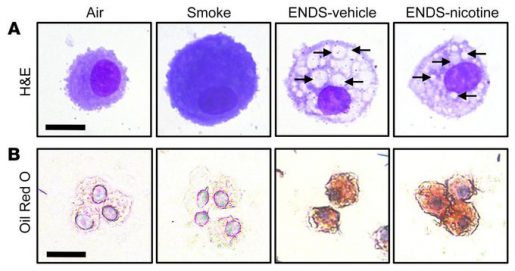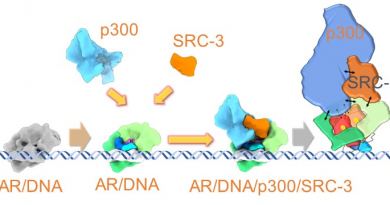E-cigarettes disrupt lung function and raise risk of infection
A study led by researchers at Baylor College of Medicine raises health concerns about the use of electronic cigarettes. Some e-cigarette-related studies have reported negative effects of vaping on health, while other reports stand for the safety of the products when compared to tobacco cigarettes. The laboratory of Dr. Farrah Kheradmand decided to shed light on this important issue.

“The opposing views on the safety of e-cigarettes prompted one of my graduate students, Matthew Madison, to investigate the effects of chronic exposure to e-cigarette vapors and to conventional tobacco smoke on murine lung function,” said Kheradmand, a pulmonologist and professor of medicine at Baylor. “We also looked at the effect of vapors or smoke on the function of immune cells called macrophages residing within the lung. These cells represent a first line of defense against viral infections such as those caused by influenza virus.”

The experimental design consisted of four groups of mice. One group was exposed to e-cigarette vapors containing nicotine in the common vaping solvents propylene glycol and vegetable glycerin, in the proportions (60/40) found in e-cigarettes. A second group received vapors with only solvents but no nicotine. These groups were compared with mice exposed to tobacco smoke or to clean air.
The mice were exposed to tobacco smoke or e-cigarette vapors for four months following a regimen equivalent to that of a person starting smoking at about teenage years until their fifth decade of life. This smoking regimen markedly increases the risk of people developing emphysema, a condition in which the lungs’ air sacs are damaged causing shortness of breath.
Unexpected findings support concerns
The researchers first found that, as expected, mice that were chronically exposed to cigarette smoke had severely damaged lungs and excessive inflammation resembling those in human smokers with emphysema.
Unexpectedly, Kheradmand, Madison and their colleagues also found that the treatment with e-cigarette vapors made of propylene glycol and vegetable glycerin solvents only (no nicotine), which are currently considered to be safe solvents, also damaged the lungs. In this case, the researchers did not observe inflammation and emphysema; instead, they found evidence of abnormal buildup of lipids (fats) in the lungs that disrupted both normal lung structure and function.
They also found that the accumulated fat was not coming from the vegetable glycerin, a type of fat, that is one of the e-cigarette solvents. Rather, the accumulated fat was from an abnormal turnover of the protective fluid layer in the lungs. In addition, they observed abnormal lipid accumulation within resident macrophages, which are involved in the turnover to this fluid protecting the lungs. Furthermore, when mice were exposed to influenza virus, those with fat-filled macrophages responded poorly to the infection.

“In summary, our experimental findings reveal that, independent of nicotine, chronic inhalation e-cigarette vapors disrupts normal murine lung function and reduces the ability of resident immune cells to respond to infection, increasing the susceptibility to diseases such as influenza,” said Kheradmand, who also holds the Nancy Chang, Ph.D. Endowed Professorship for the Biology of Inflammation Center at Baylor.
Our experimental findings share similarities with previous multiple case reports describing the presence of lipid-laden macrophages in pulmonary fluid from people with e-cigarette-associated pneumonia.”
E-cigarettes currently are the most commonly consumed tobacco substitute in the adolescent population. More than 3 million high school age adolescents as well as about 10 million adults in the U.S. are active users.
“We think that our results warrant further investigations into the solvents used in vaping,” Kheradmand said.
Read the full report in The Journal of Clinical Investigation.
Other contributors to this work include first author Matthew C. Madison, Cameron T. Landers, Bon-Hee Gu, Cheng-Yen Chang, Hui-Ying Tung, Ran You, Monica J. Hong, Nima Baghaei, Li-Zhen Song, Paul Porter, Nagireddy Putluri, Ramiro Salas, Brian E. Gilbert, Ilya Levental, Matthew J. Campen and David B. Corry.
This work was supported by NIH grants R01ES029442-01 and R01 AI135803-01, VA Merit grant CX000104, the Cytometry and Cell Sorting Core at Baylor College of Medicine with funding from the NIH (AI036211, CA125123, and RR024574), the Metabolomics Core and the Integrated Microscopy Core at Baylor.
More information: Baylor College of Medicine issues position statement on youth smoking and vaping



